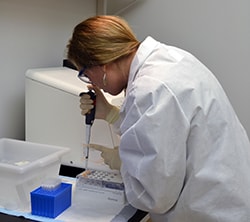CDC Works to Improve Cryptosporidium Tracking in the United States
Have you ever gotten diarrhea that won’t seem to go away? In the United States, the germ Cryptosporidium (or “Crypto” for short) sickens almost 750,000 people each year with diarrhea that can last for weeks. The disease can be especially serious in people whose immune systems are already weakened due to illness (such as HIV) or medical treatment (such as chemotherapy for cancer).
People can get sick from Crypto if they swallow food or drink water contaminated with the germ, or if they have contact with other sick people or animals or their environment. Crypto is the leading cause of waterborne disease outbreaks. The germ’s tough outer shell makes it hard to kill with chlorine, allowing it to survive in swimming pools for up to ten days.
Tracking Crypto

Thanks to DNA fingerprinting, we now know there are nearly 30 types, or species, of Crypto. They can be spread in different ways (for example, by water or different animals), and some can infect people. The different Crypto species look the same when using standard laboratory tests, such as looking under the microscope.That’s why CDC and state laboratory experts (microbiologists) use DNA fingerprinting to identify the Crypto species.
Within species, there are subtypes of Crypto that can tell us even more about how the germ is spreading. However, current DNA tests cannot tell all subtypes apart. To do so, CDC is developing advanced DNA fingerprinting techniques to look more closely at Crypto’s DNA. This will help
- identify which Crypto subtypes are infecting people,
- detect new subtypes that come into the United States,
- track how various Crypto subtypes spread in the United States, and
- better detect outbreaks caused by specific Crypto subtypes.
Next Steps for CryptoNet
CDC will upgrade the current CryptoNet tracking system with advanced DNA fingerprinting techniques. CDC scientists are looking at the entire Crypto DNA profile to find regions of the DNA that are different enough to be used for new tests that better tell subtypes apart. CDC is partnering with the Minnesota Department of Health and others to look more closely at DNA in Crypto samples from patients, animals, water, and elsewhere in the environment. Eventually, CryptoNet will combine and compare information on what patients were doing before they became sick with the more detailed Crypto DNA fingerprints. This will help CDC develop new, more effective strategies to protect people and their families and friends from Crypto.